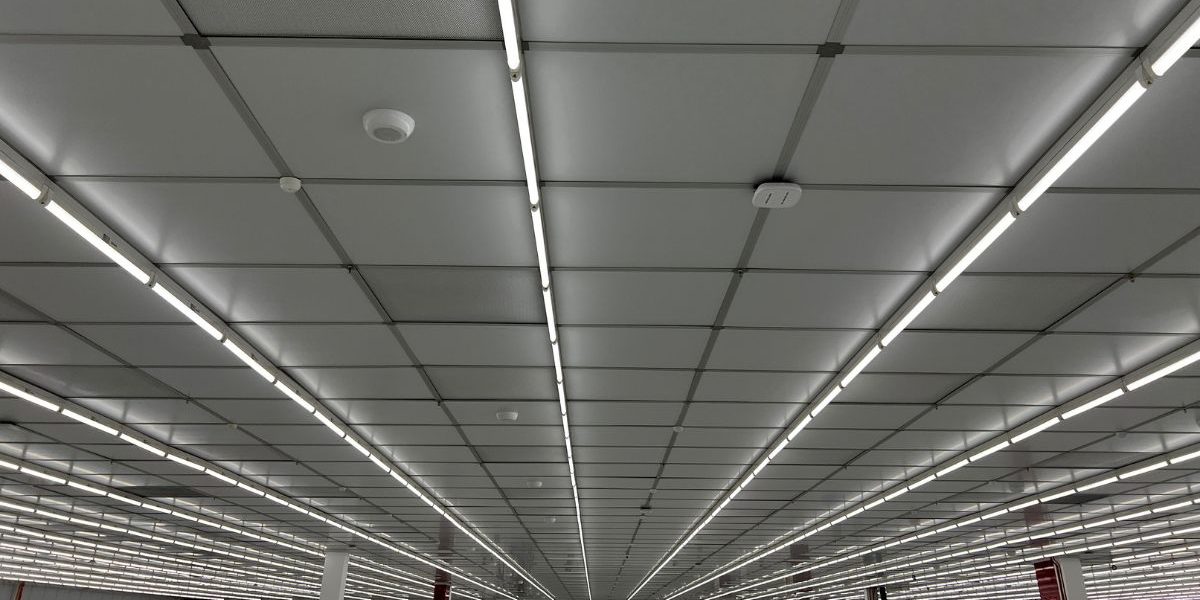Ceiling panels may not be the flashiest element in a room, but when it comes to acoustics, thermal comfort, and even aesthetics, they do a lot of heavy lifting. Whether you’re working with acoustic ceiling tiles, suspended panels, or decorative grid systems, a bit of regular maintenance goes a long way in keeping them clean, effective, and long-lasting.
1. Know What You’re Working With
First things first: understand what you’ve got overhead.
Different types of acoustic ceiling panels require different types of care.
- Acoustic panels (usually made from mineral fibre or foam) are designed to absorb sound and are more delicate.
- Metal panels are more robust and can handle deeper cleans.
- PVC or vinyl-coated tiles are moisture-resistant and easy to wipe down.
- Wood or bamboo panels may require polishing or special cleaners to prevent drying out or discolouration.
If you’re unsure, check the original packaging or the supplier’s website for care instructions. A little product knowledge can prevent costly mistakes.
2. Dust Regularly — But Gently
Dust may seem harmless, but over time, it can clog the surface of acoustic panels and reduce their sound-absorbing qualities. Worse, in commercial environments, accumulated dust can pose fire risks.
Use a microfibre duster, soft-bristled vacuum attachment, or static duster to lift the dust without scratching or pressing too hard. If you’re dealing with high ceilings, telescopic dusters are your friend — no need to risk life and limb on a ladder.
Tip: Schedule dusting for soundproof panels at least once every two to three months, or monthly in high-traffic or dusty environments.
3. Spot-Clean Stains Promptly
Watermarks, smoke discolouration, and even the odd squashed insect can leave unsightly marks. If left too long, they can set in, making cleaning almost impossible.
- Use a damp cloth or sponge with a mild, non-abrasive detergent.
- For trickier stains, diluted white vinegar or bleach can be used sparingly on non-porous materials.
- Avoid oversaturating the panel, especially if it’s porous or fibrous.
A word to the wise: if you’re dealing with nicotine stains or smoke damage, replacement is often more practical than restoration. These stains tend to penetrate deeply and discolour unevenly.
4. Keep an Eye Out for Water Damage
Ceiling panels are a frontline indicator for leaks and excess humidity. Sagging, bowing, discolouration, or a musty smell can all be red flags.
Steps to take:
- Investigate the source — don’t just patch the symptom.
- Remove affected panels to check the ceiling cavity for mould or standing water.
- Replace damaged panels immediately to prevent further deterioration or health risks.
Remember: one small leak can affect several tiles and lead to hidden mould or mildew growth.
5. Check for Loose, Warped or Misaligned Panels
Tiles can shift over time, especially in spaces with high foot traffic, ceiling-mounted equipment, or regular HVAC activity. Regular visual inspections (every 3–6 months) can help catch issues before panels fall or become safety hazards.
Quick fixes:
- Re-seat loose panels into the grid.
- Check that the metal framework hasn’t warped or sagged.
- Tighten or realign the grid if necessary.
If panels are repeatedly slipping or dropping, the grid system may be due for a full assessment or upgrade.
6. Avoid Harsh Chemicals or Abrasives
As tempting as it might be to blast a stain with bleach or scrub with steel wool, resist the urge. Many ceiling tiles — especially acoustic or fabric-wrapped ones — are highly sensitive to harsh cleaners.
Stick to:
- Mild dish soap and water
- White vinegar for natural cleaning
- Specialist cleaners recommended by the manufacturer
And always blot, don’t rub. Vigorous scrubbing can damage the surface or reduce the panel’s acoustic effectiveness.
7. Don’t Forget the Grid System
The support grid can collect just as much dust, and if neglected, it can corrode, discolour, or loosen, making your clean panels look shabby by comparison.
- Wipe down the grid with a damp cloth or mild cleaner.
- Tighten any loose cross tees or wall angles.
- Spray-paint or polish rusty sections as needed to maintain appearance.
Regular grid care keeps the entire system secure and polished-looking.
8. Schedule Professional Cleaning When Necessary
There are some tasks you can do yourself, and others best left to the pros. If your ceiling:
- Is higher than 3 metres
- Involves specialist materials
- Is in a commercial space with regulatory standards
- Shows widespread mould or staining
…it’s worth bringing in a professional ceiling cleaning service. They’ll have the equipment, scaffolding, and expertise to restore your ceiling without causing damage or violating safety codes.
Bonus: Many services also offer antimicrobial or anti-static treatments.
9. Replace Rather Than Over-Clean
Sometimes the most efficient solution is the simplest one: just replace the tile.
If a panel is:
- Cracked or crumbling
- Water-damaged or stained beyond repair
- Discoloured from age
- Warped or no longer fitting properly
…it’s time to replace it. Keep a few spare panels on hand for just such occasions, particularly for older models or discontinued lines.
Replacing a single tile keeps the ceiling looking sharp and prevents a domino effect of other tiles becoming damaged or displaced.
10. Keep an Inventory of Spare Panels
Ceiling panels, like paint colours, can be maddeningly difficult to match later. Manufacturers phase out styles, materials fade, and new batches may not look quite the same. Keep 5–10% of your original tile quantity in storage.
Label them clearly, store them flat in a dry space, and avoid stacking anything heavy on top.
Having replacements ready means no delays in the event of an accident, leak, or impromptu renovation.
Final Thoughts: Maintenance Is Quietly Powerful
Ceiling panels are easy to overlook — but ignore them for too long, and you’ll notice. Dust, stains, and misalignments not only compromise the look of your space but also impact acoustic performance, hygiene, and in some cases, even health.
Incorporating light, regular maintenance into your routine, you ensure your ceiling panels continue doing their job: quietly, efficiently, and elegantly.










